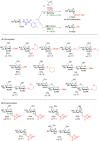Strategies toward protecting group-free glycosylation through selective activation of the anomeric center
- PMID: 28694870
- PMCID: PMC5496566
- DOI: 10.3762/bjoc.13.123
Strategies toward protecting group-free glycosylation through selective activation of the anomeric center
Abstract
Glycosylation is an immensely important biological process and one that is highly controlled and very efficient in nature. However, in a chemical laboratory the process is much more challenging and usually requires the extensive use of protecting groups to squelch reactivity at undesired reactive moieties. Nonetheless, by taking advantage of the differential reactivity of the anomeric center, a selective activation at this position is possible. As a result, protecting group-free strategies to effect glycosylations are available thanks to the tremendous efforts of many research groups. In this review, we showcase the methods available for the selective activation of the anomeric center on the glycosyl donor and the mechanisms by which the glycosylation reactions take place to illustrate the power these techniques.
Keywords: glycosides; glycosylation; oligosaccharides; protecting groups.
Figures























































Similar articles
-
Aglycon reactivity as a guiding principle in latent-active approach to chemical glycosylations.Carbohydr Res. 2021 Oct;508:108404. doi: 10.1016/j.carres.2021.108404. Epub 2021 Jul 29. Carbohydr Res. 2021. PMID: 34352649 Review.
-
Taming the Reactivity of Glycosyl Iodides To Achieve Stereoselective Glycosidation.Acc Chem Res. 2016 Jan 19;49(1):35-47. doi: 10.1021/acs.accounts.5b00357. Epub 2015 Nov 2. Acc Chem Res. 2016. PMID: 26524481
-
Venturing beyond Donor-Controlled Glycosylation: New Perspectives toward Anomeric Selectivity.Acc Chem Res. 2018 Mar 20;51(3):628-639. doi: 10.1021/acs.accounts.7b00449. Epub 2018 Feb 22. Acc Chem Res. 2018. PMID: 29469568 Review.
-
Chemoselective Glycosylations. 2. Differences in Size of Anomeric Leaving Groups Can Be Exploited in Chemoselective Glycosylations.J Org Chem. 1997 Nov 14;62(23):8145-8154. doi: 10.1021/jo971233k. J Org Chem. 1997. PMID: 11671924
-
Harnessing Free Sulfate Groups in Glycosylation Reactions.Angew Chem Int Ed Engl. 2025 Jan 21;64(4):e202416743. doi: 10.1002/anie.202416743. Epub 2024 Dec 6. Angew Chem Int Ed Engl. 2025. PMID: 39540622
Cited by
-
Nucleoside Analogs: A Review of Its Source and Separation Processes.Molecules. 2023 Oct 12;28(20):7043. doi: 10.3390/molecules28207043. Molecules. 2023. PMID: 37894522 Free PMC article. Review.
-
Streamlined Iterative Assembly of Thio-Oligosaccharides by Aqueous S-Glycosylation of Diverse Deoxythio Sugars.ChemSusChem. 2022 Feb 8;15(3):e202102483. doi: 10.1002/cssc.202102483. Epub 2022 Jan 10. ChemSusChem. 2022. PMID: 34911160 Free PMC article.
-
Protecting group free glycosylation: one-pot stereocontrolled access to 1,2-trans glycosides and (1→6)-linked disaccharides of 2-acetamido sugars.Chem Sci. 2022 Mar 17;13(14):4122-4130. doi: 10.1039/d2sc00222a. eCollection 2022 Apr 6. Chem Sci. 2022. PMID: 35440979 Free PMC article.
-
Solid-Phase Synthesis of Megamolecules.J Am Chem Soc. 2020 Mar 11;142(10):4534-4538. doi: 10.1021/jacs.9b12003. Epub 2020 Mar 3. J Am Chem Soc. 2020. PMID: 32105451 Free PMC article.
-
Trends in lactose-derived bioactives: synthesis and purification.Syst Microbiol Biomanuf. 2022;2(3):393-412. doi: 10.1007/s43393-021-00068-2. Epub 2022 Jan 21. Syst Microbiol Biomanuf. 2022. PMID: 38624767 Free PMC article. Review.
References
Publication types
LinkOut - more resources
Full Text Sources
Other Literature Sources
Research Materials
